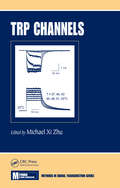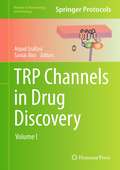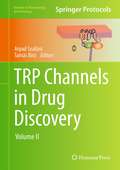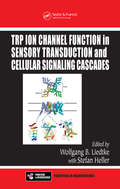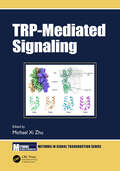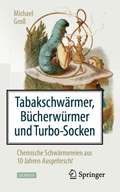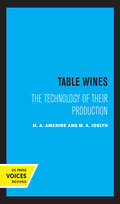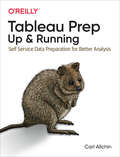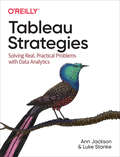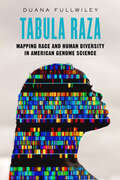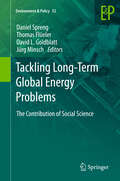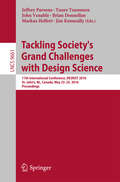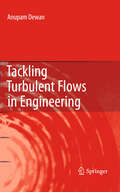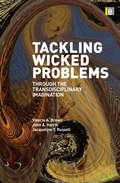- Table View
- List View
TRP Channels (Methods in Signal Transduction Series)
by Michael X. ZhuThe rapid expansion of the TRP field has generated a large amount of excellent original work across many different research fields. However, investigators are not necessarily familiar with the pros and cons of the variety of methods used to study TRP channels. Because of functional and genetic diversity, as well as the different physiological roles
TRP Channels in Drug Discovery, Volume I
by Arpad Szallasi Tamás BíróRecent findings have implied a distinct therapeutic potential for drugs targeting Transient Receptor Potential (TRP) channels in a wide variety of diseases, many with no existing satisfactory treatment options. Thus, the TRP superfamily of ion channels has attracted a great deal of well-deserved attention. TRP Channels in Drug Discovery provides a thorough collection of the most up-to-date reviews and protocols on the subject, coming from top experts in the field. Volume I presents a series of state-of-the-art minireviews on the most interesting TRP channels (from TRPA1 to TRPV4), as well as TRP-related protocols involving airways and the genitourinary tract. Written for the Methods in Pharmacology and ToxicologyTM series, this work includes the kind of detailed description and key implementation advice that ensures successful results in the lab. Comprehensive and cutting-edge, TRP Channels in Drug Discovery serves as an ideal reference for graduate students in academic laboratories as well as for pharmaceutical scientists developing new drugs and clinicians interested in novel drugs in the pipeline.
TRP Channels in Drug Discovery, Volume II
by Arpad Szallasi Tamás BíróRecent findings have implied a distinct therapeutic potential for drugs targeting Transient Receptor Potential (TRP) channels in a wide variety of diseases, many with no existing satisfactory treatment options. Thus, the TRP superfamily of ion channels has attracted a great deal of well-deserved attention. TRP Channels in Drug Discovery provides a thorough collection of the most up-to-date reviews and protocols on the subject, coming from top experts in the field. Volume II presents practical methodologies involving models for disorders of the cardiovascular system, the brain, skin, the metabolic system, as well as colitis, cancer, thermosensation, and musculoskeletal disorders. Written for the Methods in Pharmacology and ToxicologyTM series, this work includes the kind of detailed description and key implementation advice that ensures successful results in the lab.<P><P> Comprehensive and cutting-edge, TRP Channels in Drug Discovery serves as an ideal reference for graduate students in academic laboratories as well as for pharmaceutical scientists developing new drugs and clinicians interested in novel drugs in the pipeline.
TRP Ion Channel Function in Sensory Transduction and Cellular Signaling Cascades (Frontiers in Neuroscience)
by Wolfgang B. Liedtke Stefan HellerSince the first TRP ion channel was discovered in Drosophila melanogaster in 1989, the progress made in this area of signaling research has yielded findings that offer the potential to dramatically impact human health and wellness. Involved in gateway activity for all five of our senses, TRP channels have been shown to respond to a wide range of st
TRP-Mediated Signaling (Methods in Signal Transduction Series)
by Michael Xi ZhuThe field of transient receptor potential (TRP) channels has gained momentum in recent years not only because of the 2021 Nobel Prize in Physiology or Medicine awarded to David Julius and Ardem Patapoutian for their discoveries of receptors for temperature and touch, but also because of the growing appreciation of the diverse and important physiological and pathophysiological functions of this diverse family of cation channels. In the past decade, there have been important discoveries in the TRP field: resolution of the 3-D structures of major subfamilies using single-particle cryogenic electron microscopy and X-ray crystallography, identification and development of selective agonists and antagonists for most TRP subfamily members, discovery of new human diseases associated with TRP gene mutations, as well as improved understanding of TRP channel function and regulation in various systems. These new discoveries are addressed in TRP-Mediated Signaling, a volume in the Methods in Signal Transduction book series.Key Features• Summarizes recent advances in the study of TRP channels• Written by a team of leading international researchers• Reviews physiological and pathophysiological functions of TRP channels• Identifies diseases associated with TRP gene mutations• Examines the evolution of temperature-sensing TRP channels
Tabakschwärmer, Bücherwürmer und Turbo-Socken: Chemische Schwärmereien aus 10 Jahren Ausgeforscht
by Michael GroßDieses Buch präsentiert 70 Merkwürdigkeiten der „Ausgeforscht“-Glossen der Nachrichten aus der Chemie von Michael Groß. Obskure Aspekte und Meldungen aus der Wissenschaft werden aufgespießt und die Lesenden damit sowohl zum Schmunzeln als auch zum Nachdenken angeregt. Eingehend analysiert, in Kakao inkubiert und in Heiterkeit aufgelöst wird dabei auch die Wechselwirkung zwischen Wissenschaft und Technologie, dem menschlichen Alltagsleben und Konsumverhalten: von stinkenden Socken bis hin zu den perlenden Gasblasen des Champagner.Der wissenschaftliche Hintergrund der Glossen erstreckt sich von der Biologie über die Chemie bis hin zur Quantenmechanik - der alltäglich-kuriose Vordergrund von neumodischen, völlig überflüssigen Erfindungen bis hin zu traditionellen Grundnahrungsmitteln wie Bier und Wein.Der Autor Michael Groß studierte Chemie und erforschte am Oxford Centre for Molecular Sciences die biophysikalische Chemie der Proteine. Heute lebt er als freier Wissenschaftsjournalist in Oxford und schreibt regelmäßig Sachbücher und Beiträge u.a. für Spektrum der Wissenschaft, Chemie in unserer Zeit und Nachrichten aus der Chemie. 2014 wurde er von der Gesellschaft Deutscher Chemiker mit dem GDCh-Preis für Journalisten und Schriftsteller ausgezeichnet.
Table Wines: The Technology of Their Production
by M. A. Amerine M.A. JoslynThis title is part of UC Press's Voices Revived program, which commemorates University of California Press’s mission to seek out and cultivate the brightest minds and give them voice, reach, and impact. Drawing on a backlist dating to 1893, Voices Revived makes high-quality, peer-reviewed scholarship accessible once again using print-on-demand technology. This title was originally published in 1970.
Tableau Prep: Self-service Data Preparation For Better Analysis
by Carl AllchinFor self-service data preparation, Tableau Prep is relatively easy to use—as long as you know how to clean and organize your datasets. Carl Allchin, from The Information Lab in London, gets you up to speed on Tableau Prep through a series of practical lessons that include methods for preparing, cleaning, automating, organizing, and outputting your datasets.Based on Allchin’s popular blog, Preppin’ Data, this practical guide takes you step-by-step through Tableau Prep’s fundamentals. Self-service data preparation reduces the time it takes to complete data projects and improves the quality of your analyses. Discover how Tableau Prep helps you access your data and turn it into valuable information.Know what to look for when you prepare dataLearn which Tableau Prep functions to use when working with data fieldsAnalyze the shape and profile of your datasetOutput data for analysis and learn how Tableau Prep automates your workflowLearn how to clean your dataset using Tableau Prep functionsExplore ways to use Tableau Prep techniques in real-world scenariosMake your data available to others by managing and documenting the output
Tableau Strategies: Solving Real, Practical Problems with Data Analytics
by Ann Jackson Luke StankeIf you want to increase Tableau's value to your organization, this practical book has your back. Authors Ann Jackson and Luke Stanke guide data analysts through strategies for solving real-world analytics problems using Tableau. Starting with the basics and building toward advanced topics such as multidimensional analysis and user experience, you'll explore pragmatic and creative examples that you can apply to your own data.Staying competitive today requires the ability to quickly analyze and visualize data and make data-driven decisions. With this guide, data practitioners and leaders alike will learn strategies for building compelling and purposeful visualizations, dashboards, and data products. Every chapter contains the why behind the solution and the technical knowledge you need to make it work.Use this book as a high-value on-the-job reference guide to TableauVisualize different data types and tackle specific data challengesCreate compelling data visualizations, dashboards, and data productsLearn how to generate industry-specific analyticsExplore categorical and quantitative analysis and comparisonsUnderstand geospatial, dynamic, statistical, and multivariate analysisCommunicate the value of the Tableau platform to your team and to stakeholders
Tabula Raza: Mapping Race and Human Diversity in American Genome Science (Atelier: Ethnographic Inquiry in the Twenty-First Century #14)
by Duana FullwileyDuana Fullwiley has penned an intimate chronicle of laboratory life in the genomic age. She presents many of the influential scientists at the forefront of genetics who have redefined how we practice medicine and law and understand ancestry in an era of big data and waning privacy. Exceedingly relatable and human, the scientists in these pages often struggle for visibility, teeter on the tightrope of inclusion, and work tirelessly to imprint the future. As they actively imagine a more equal and just world, they often find themselves ensnared in reproducing timeworn conceits of race and racism that can seed the same health disparities they hope to resolve. Nothing dynamic can live for long as a blank slate, an innocent tabula rasa. But how the blank slate of the once-raceless human genome became one of racial differences, in various forms of what Fullwiley calls the tabula raza, has a very specific and familiar history—one that has cycled through the ages in unexpected ways.
Tackling Long-Term Global Energy Problems: The Contribution of Social Science
by Daniel Spreng Thomas Flüeler David L. Goldblatt Jürg MinschThis book makes a case for a multidisciplinary and transdisciplinary approach to energy research--one that brings more of the social sciences to bear. Featuring eight studies from across the spectrum of the social sciences, each applying multiple disciplines to one or more energy-related problems, the book demonstrates the strong analytical and policy-making potential of such a broadened perspective. Case studies include: energy transitions of households in developing countries, the 'curse of oil', politics and visions for renewables, economics and ethics in emissions trading, and carbon capture and storage.
Tackling Society's Grand Challenges with Design Science
by Markus Helfert Jeffrey Parsons Tuure Tuunanen John Venable Brian Donnellan Jim KenneallyThis book constitutes the thoroughly refereed proceedings of the 11th International Conference on Design Science Research in Information Systems and Technology, DESRIST 2016, held in St. John, Newfoundland, Canada, in May 2016. The 11 full papers, 2 short papers and 9 short papers describing prototypes and products were carefully reviewed and selected from 54 submissions. The papers are organized around the following topics: methodological aspects of design science; applications of design science research to real world design problems, for example in social media, health care systems, embedded technologies, climate, security.
Tackling Turbulent Flows in Engineering
by Anupam DewanThe emphasis of this book is on engineering aspects of fluid turbulence. The book explains for example how to tackle turbulence in industrial applications. It is useful to several disciplines, such as, mechanical, civil, chemical, aerospace engineers and also to professors, researchers, beginners, under graduates and post graduates. The following issues are emphasized in the book: - Modeling and computations of engineering flows: The author discusses in detail the quantities of interest for engineering turbulent flows and how to select an appropriate turbulence model; Also, a treatment of the selection of appropriate boundary conditions for the CFD simulations is given. - Modeling of turbulent convective heat transfer: This is encountered in several practical situations. It basically needs discussion on issues of treatment of walls and turbulent heat fluxes. - Modeling of buoyancy driven flows, for example, smoke issuing from chimney, pollutant discharge into water bodies, etc
Tackling Wicked Problems: Through the Transdisciplinary Imagination
by John Harris Valerie A Brown Jacqueline RussellFrom climate change to GM foods, we are increasingly confronted with complex, interconnected social and environmental problems that span disciplines, knowledge bases and value systems. This book offers a transdisciplinary, open approach for those working towards resolving these 'wicked' problems and highlights the crucial role of this 'transdisciplinary imagination' in addressing the shift to sustainable futures. Tackling Wicked Problems provides readers with a framework and practical examples that will guide the design and conduct of their own open-ended enquiries. In this approach, academic disciplines are combined with personal, local and strategic understanding and researchers are required to recognise multiple knowledge cultures, accept the inevitability of uncertainty, and clarify their own and others' ethical positions. The authors then comment on fifteen practical examples of how researchers have engaged with the opportunities and challenges of conducting transdisciplinary inquiries. The book gives those who are grappling with complex problems innovative methods of inquiry that will allow them to work collaboratively towards long-term solutions.
Tackling the Inverse Problem for Non-Autonomous Systems: Application to the Life Sciences
by Tomislav StankovskiThis thesis presents a new method for following evolving interactions between coupled oscillatory systems of the kind that abound in nature. Examples range from the subcellular level, to ecosystems, through climate dynamics, to the movements of planets and stars. Such systems mutually interact, adjusting their internal clocks, and may correspondingly move between synchronized and non-synchronized states. The thesis describes a way of using Bayesian inference to exploit the presence of random fluctuations, thus analyzing these processes in unprecedented detail. It first develops the basic theory of interacting oscillators whose frequencies are non-constant, and then applies it to the human heart and lungs as an example. Their coupling function can be used to follow with great precision the transitions into and out of synchronization. The method described has the potential to illuminate the ageing process as well as to improve diagnostics in cardiology, anesthesiology and neuroscience, and yields insights into a wide diversity of natural processes.
Taconite Dreams: The Struggle to Sustain Mining on Minnesota’s Iron Range, 1915-2000
by Jeffrey T. ManuelWinner of the Midwestern History Association's 2016 Hamlin Garland Prize The Iron Range earned its name honestly: it was once among the world&’s richest iron ore mining districts. The Iron Range propelled the U.S. steel industry in the late nineteenth century, and iron mining sustained generations in the region with work and a strong economy. But long before most other parts of the country faced the realities of industrial decline, Minnesota&’s Iron Range was already striving to maintain its core industry.In Taconite Dreams: The Struggle to Sustain Mining on Minnesota&’s Iron Range, 1915–2000, Jeffrey T. Manuel examines how the region fought the dislocation that came with economic changes, technological advances, and global shifts in industrial production. On the Iron Range, efforts included the development of taconite mining as a technological fix for the drop in hematite mining. Manuel describes the Iron Range&’s modern history and how the downturn was opposed by individuals, civic groups, and commercial interests. The first book dedicated to thoroughly exploring this era on the Iron Range, Taconite Dreams demonstrates how the area fit into a larger story of regions wrestling with deindustrialization in the twentieth century. The 1964 taconite amendment to Minnesota&’s constitution, the bruising federal pollution lawsuit that closed a taconite plant, and the Iron Range Resources and Rehabilitation Board&’s economic development policy are all discussed.Ultimately, the resistance against economic decline is also a battle over mining&’s memory and legacy, one that continues today. Manuel&’s history sheds much-needed light on this important yet widely overlooked mining region as well as the impact of the past century&’s struggles on the people who call it home.
Tactical Combat Casualty Care and Wound Treatment
by U.S. Department of DefenseMilitary surgeons must assume a leadership role in combat casualty care in circumstances that are far less than ideal. This handbook provides much of the information needed to tackle these issues and features state-of-the-art principles and practices of forward trauma surgery as used by military physicians in far flung locations around the globe. In this volume you’ll learn such integral skills as: * Tactical field care * Field dressing * Applying pressure dressing * Treating burns * Treating inhalation injuries * And more! Tactical Combat Casualty Care and Wound Treatment is the most trusted and up-to-date manual offered by the Department of Defense for military medical personnel in the field.
Tactical Crime Analysis: Research and Investigation
by Derek J. Paulsen Sean Bair Dan HelmsResearch has shown that the majority of crimes are committed by persistent or serial offenders, with as little as seven percent of offenders accounting for approximately 60 percent of all crimes. By focusing police efforts on these prolific offenders and learning to identify, analyze, and resolve the crimes they commit, the law enforcement communit
Tactical Display for Soldiers: Human Factors Considerations
by Panel on Human Factors in the Design of Tactical Display Systems for the Individual SoldierThis book examines the human factors issues associated with the development, testing, and implementation of helmet-mounted display technology in the 21st Century Land Warrior System.Because the framework of analysis is soldier performance with the system in the full range of environments and missions, the book discusses both the military context and the characteristics of the infantry soldiers who will use the system. The major issues covered include the positive and negative effects of such a display on the local and global situation awareness of the individual soldier, an analysis of the visual and psychomotor factors associated with each design feature, design considerations for auditory displays, and physical sources of stress and the implications of the display for affecting the soldier's workload. The book proposes an innovative approach to research and testing based on a three-stage strategy that begins in the laboratory, moves to controlled field studies, and culminates in operational testing.
Tactile Score
by Yasuhiro Suzuki Rieko SuzukiThis book deals with one of the most novel advances in natural computing, namely, in the field of tactile sense analysis. Massage, which provides relaxation and stimulation for human beings, is analyzed in this book for the first time by encoding the motions and tactile senses involved. The target audience is not limited to researchers who are interested in natural computing but also includes those working in ergonomic design, biomedical engineering, Kansei engineering, and cognitive science.
Tactile Sensing and Display
by Saeed Sokhanvar Siamak Arbatani Siamak Najarian Javad DargahiComprehensively covers the key technologies for the development of tactile perception in minimally invasive surgeryCovering the timely topic of tactile sensing and display in minimally invasive and robotic surgery, this book comprehensively explores new techniques which could dramatically reduce the need for invasive procedures. The tools currently used in minimally invasive surgery (MIS) lack any sort of tactile sensing, significantly reducing the performance of these types of procedures. This book systematically explains the various technologies which the most prominent researchers have proposed to overcome the problem. Furthermore, the authors put forward their own findings, which have been published in recent patents and patent applications. These solutions offer original and creative means of surmounting the current drawbacks of MIS and robotic surgery.Key features:-Comprehensively covers topics of this ground-breaking technology including tactile sensing, force sensing, tactile display, PVDF fundamentalsDescribes the mechanisms, methods and sensors that measure and display kinaesthetic and tactile data between a surgical tool and tissueWritten by authors at the cutting-edge of research into the area of tactile perception in minimally invasive surgeryProvides key topic for academic researchers, graduate students as well as professionals working in the area
Tag-based Next Generation Sequencing (Molecular Plant Biology Ser.)
by Matthias Harbers Günter KahlTag-based approaches were originally designed to increase the throughput of capillary sequencing, where concatemers of short sequences were first used in expression profiling. New Next Generation Sequencing methods largely extended the use of tag-based approaches as the tag lengths perfectly match with the short read length of highly parallel sequencing reactions. Tag-based approaches will maintain their important role in life and biomedical science, because longer read lengths are often not required to obtain meaningful data for many applications. Whereas genome re-sequencing and de novo sequencing will benefit from ever more powerful sequencing methods, analytical applications can be performed by tag-based approaches, where the focus shifts from 'sequencing power' to better means of data analysis and visualization for common users. Today Next Generation Sequence data require powerful bioinformatics expertise that has to be converted into easy-to-use data analysis tools. The book's intention is to give an overview on recently developed tag-based approaches along with means of their data analysis together with introductions to Next-Generation Sequencing Methods, protocols and user guides to be an entry for scientists to tag-based approaches for Next Generation Sequencing.
Tagging and Tracking of Marine Animals with Electronic Devices
by Alistair Hobday Molly Lutcavage Haritz Arrizabalaga Nuno Fragoso Jennifer L. Nielsen John SibertThe 2nd international tagging and tracking symposium was held in San Sebastian, Spain, in October 2007, seven years after the first symposium was held in Hawaii in 2000 (Sibert and Nielsen 2001). In the intervening seven years, there have been major advances in both the capability and reliability of electronic tags and analytical approaches for geolocation of tagged animals in marine habitats. Advances such as increased data storage capacity, sensor development, and tag miniaturization have allowed researchers to track a much wider array of marine animals, not just large and charismatic species. Importantly, data returned by these tags are now being used in population analyses and movement simulations that can be directly utilized in stock assessments and other management applications. Papers in this volume are divided into three sections, the first describing insights into behavior achieved using acoustic, archival, and novel tags, the second reporting on advances in methods of geolocation, while the final section includes contributions where tag data have been used in management of marine species. Accurate documentation of animal movements and behaviors in critical marine habitats are impossible to obtain with other technologies. The management and conservation of marine species are critical in today's changing ocean environment and as electronic tags become more accurate and functional for a diversity of organisms their application continues to grow, setting new standards in science and technology.
Tagore, Einstein and the Nature of Reality: Literary and Philosophical Reflections (Routledge Studies In The Philosophy Of Mathematics And Physics Ser.)
by Partha GhoseThis volume consists of a selection of scholarly essays from literature, philosophy and history on the conception of reality as understood by Rabindranath Tagore and Albert Einstein. The nature of reality has been a long-debated issue among scientists and philosophers. Tagore (1861–1941) met Einstein (1879–1955) at the latter’s house in Kaputh, Germany on 14 July 1930 and had a long conversation on this issue. This conversation has been widely quoted and discussed by scientists, philosophers and scholars from the literary world. The important question that Tagore and Einstein discussed was whether the world is a unity dependent on humanity, or the world is a reality independent of the human factor. Einstein believed that reality is independent of the mind and the human factor. On the other hand, Tagore adopted the opposite view. Nevertheless, both Einstein and Tagore claimed to be realists — their conceptions of reality were obviously fundamentally different. Where does the difference lie? Can it be harmonized at a deeper level? This volume brings together for the first time a gamut of views on this subject from eminent scholars. It presents some key reflections on reality, language, poetry, truth, science, personality, human sciences, virtue ethics, intelligibility and creativity. It will be useful to scholars and researchers of philosophy, literature, history and political studies, as also to those interested in Tagore.
Tahoma and its People: A Natural History of Mount Rainier National Park
by Jeff Antonelis-LappA magnificent active volcano, Mount Rainier ascends to 14,410 feet above sea level--the highest in Washington State. The source of five major rivers, it has more glaciers than any other peak in the contiguous U.S. Its slopes are home to ancient forests, spectacular subalpine meadows, and unique, captivating creatures. <p><p>In Tahoma and Its People, a passionate, informed, hands-on science educator presents a natural and environmental history of Mount Rainier National Park and the surrounding region. Jeff Antonelis-Lapp explores geologic processes that create and alter landscapes, interrelationships within and between plant and animal communities, weather and climate influences on ecosystems, and what linked the iconic mountain with the people who traveled to it for millennia. He intersperses his own direct observation and study of organisms, as well as personal interactions with rangers, archaeologists, a master Native American weaver, and others. He covers a plethora of topics: geology, archaeology, indigenous villages and use of resources, climate and glacier studies, alpine and forest ecology, rivers, watershed dynamics, keystone species, threatened wildlife, geological hazards, and current resource management. Numerous color illustrations, maps, and figures supplement the text. <p><p>2020 Banff Mountain Book Competition Finalist, Mountain Environment and Natural History category
